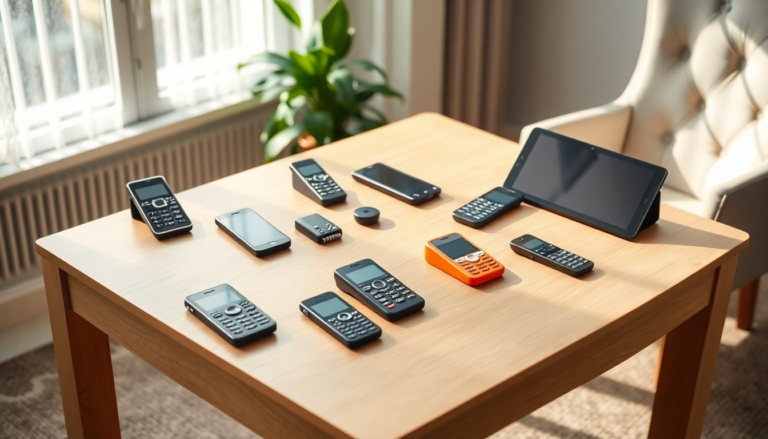Argomenti trattati
As we step into 2025, the market for cell phones tailored for seniors is buzzing with activity. With a growing array of options, choosing the right device can feel overwhelming. But don’t worry! This guide is here to streamline your search by spotlighting the best cell phones that blend senior-friendly features, affordability, and quality. Our recommendations come from thorough testing and valuable feedback from seniors, ensuring we address their specific needs.
Market Overview and Key Factors
The landscape of cell phones for seniors has transformed, focusing on user-friendly interfaces, cost-effectiveness, and vital functionalities. Today’s best devices prioritize senior-friendly features—think larger buttons, simplified menus, and enhanced sound quality. We’ve meticulously analyzed various models, considering usability, battery life, and overall value.
Among the top contenders, the Consumer Cellular’s IRIS Easy Flip truly shines as the most suitable choice for many seniors. Priced at just $59, this device boasts a straightforward design with essential features like texting, calling, and internet browsing. It perfectly balances affordability and functionality, making it an appealing option for seniors.
If you’re leaning towards smartphones, the Jitterbug Smart4, priced at $119.99, is our top pick. This device merges modern smartphone capabilities with an intuitive interface tailored specifically for seniors. It’s an excellent choice for those who crave more advanced features without the tech overload.
Analyzing Popular Models
In our testing, we paid keen attention to how seniors interacted with different models. The IRIS Easy Flip, with its large keys and clear exterior screen, proved to be incredibly user-friendly right out of the box. Seniors appreciated its simplicity and the straightforward process for charging and accessing features.
On the flip side, the Jitterbug Smart4 garnered praise for its effortless navigation and voice command capabilities, enabling seniors to send texts and make calls without the hassle of navigating complicated settings. However, it’s worth noting that some users experienced a slight delay in responsiveness, which could be a drawback for those who prefer speedy interactions.
When we took a closer look at the Samsung Galaxy A16 5G, we were impressed by its fantastic camera and robust battery life. Yet, its brightness settings might create challenges for seniors using it outdoors. Similarly, the premium iPhone 16 offers advanced features but can overwhelm those who aren’t as tech-savvy. Both models underscore the importance of usability alongside performance.
Pricing Trends and Investment Opportunities
The pricing landscape for senior-friendly cell phones clearly trends toward affordability without compromising on quality. The IRIS Easy Flip and Jitterbug models represent strong investments, given their impressive features and price points. With monthly plans starting as low as $14.99, seniors can find options that fit their budgets while enjoying essential communication features.
As the market continues to evolve, it’s vital for seniors and their families to consider not only the initial cost of the device but also the ongoing expenses linked to service plans. Many carriers have tailored their offerings specifically to meet senior needs, making it easier to find solutions that deliver both value and flexibility.
In terms of investment, selecting a phone that meets both immediate needs and offers potential for future use is crucial. Seniors should seek devices that promise longevity in terms of features and service plans designed for their demographic.
Practical Tips for Choosing the Right Phone
When picking a cell phone, seniors should prioritize ease of use, essential features, and compatibility with hearing aids if necessary. It’s also wise to consider screen size and clarity, especially for those with visual impairments. Exploring options that support voice commands can significantly enhance usability.
Additionally, seniors should ask about trial periods or return policies when purchasing a new phone. This allows them to test the device in real-life situations to ensure it meets their expectations. Consulting with family members or tech-savvy friends can also provide valuable insights and support during the selection process.
Finally, staying informed about the latest models and market trends is essential. The right phone can greatly enhance communication, connectivity, and even safety for seniors, making it an important investment for their daily lives.
Medium-Term Predictions
Looking ahead, the market for senior cell phones is set for continued growth and innovation. As technology increasingly integrates into daily life, manufacturers are likely to focus on creating devices that are not only user-friendly but also equipped with features that cater to the ever-evolving needs of seniors.
We expect to see further advancements in accessibility features, such as voice recognition and improved compatibility with hearing aids, making devices even more approachable for seniors. Additionally, with the demand for smartphones on the rise, more budget-friendly options that don’t skimp on quality or essential features should hit the market.
In conclusion, choosing the right cell phone for seniors in 2025 involves weighing factors like ease of use, pricing, and technological advancements. As we move forward, staying attuned to these developments will be key to ensuring that seniors remain connected, informed, and engaged in their communities.

